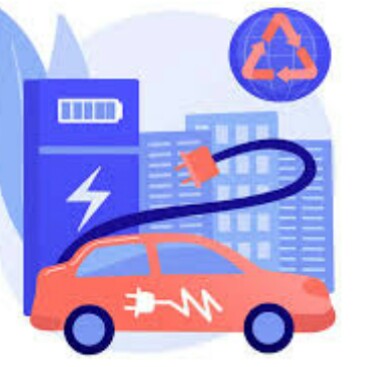Electric Vehicle
The United States adoption of electric vehicles (EVs)
The United States is experiencing a surge in the adoption of electric vehicles (EVs) as more Americans recognize the environmental and economic benefits of transitioning to electric mobility.
With increasing investments in charging infrastructure, supportive government policies, and advancements in technology, the country is at the forefront of the global shift towards sustainable transportation.
In this article, we explore the journey of electric vehicles in the United States, examine the driving factors behind their success, and discuss the environmental and economic advantages they offer.
Government Initiatives and Incentives:
The U.S. government has been proactive in supporting the adoption of electric vehicles through various initiatives and incentives. Federal tax credits are available for purchasing electric vehicles, reducing the upfront cost and making them more affordable for consumers. Additionally, several states offer additional incentives such as rebates, grants, and exemptions from certain taxes. The government is also investing in the expansion of charging infrastructure networks, aiming to install thousands of charging stations across the country, making EV charging more accessible and convenient.
Charging Infrastructure Development:
The United States is rapidly expanding its charging infrastructure to cater to the growing number of electric vehicles on its roads. Public charging stations can be found in urban areas, shopping centers, workplaces, and along highways, ensuring that EV owners have convenient access to charging facilities. The development of fast-charging networks, capable of delivering a significant charge in a short amount of time, is easing concerns about range anxiety and enabling longer trips. Innovative solutions such as wireless charging technology and smart grid integration are also being explored to further enhance the charging experience.
Advancements in Technology and Manufacturing:
The United States is a hub for technological innovation and has a thriving electric vehicle manufacturing industry. Established automakers, as well as startups, are investing heavily in the development of electric vehicles with improved range, performance, and affordability. The country’s expertise in battery technology and electric drivetrains has positioned it as a leader in the global electric vehicle market. Furthermore, collaborations between automakers and technology companies are driving advancements in autonomous driving and connected vehicle technologies, shaping the future of electric mobility.
Environmental Benefits and Climate Action:
The transition to electric vehicles in the United States brings significant environmental benefits. EVs produce zero tailpipe emissions, reducing greenhouse gas emissions and improving air quality. By replacing conventional internal combustion engines with electric powertrains, the United States can make substantial progress towards achieving its climate goals and mitigating the impacts of climate change. Furthermore, when charged with renewable energy sources, such as wind or solar power, electric vehicles contribute to a cleaner and more sustainable energy mix.
Economic Opportunities and Job Creation:
The growing electric vehicle industry in the United States presents significant economic opportunities and job creation. The manufacturing of electric vehicles and components stimulates investments, innovation, and the creation of skilled jobs in areas such as engineering, manufacturing, and supply chain management. Additionally, the development of charging infrastructure and the integration of renewable energy sources create employment opportunities in the clean energy sector. The growth of the electric vehicle market also supports local economies, fosters technological advancements, and enhances the country’s global competitiveness.
Goverment Policy for Electric Vehicle in United States
The United States government has implemented several policies and initiatives to promote the adoption and use of electric vehicles (EVs). However, please note that policies may have changed since then, and it’s always a good idea to refer to the latest information from official sources.
Here are some key government policies related to electric vehicles in the United States up to that point:
1. Federal Tax Credits: The U.S. government has offered federal tax credits for the purchase of qualified electric vehicles. These credits vary depending on the vehicle’s battery size. However, it’s essential to check with the Internal Revenue Service (IRS) or official government websites for the latest information on tax credits, as they may have changed.
2. Fuel Economy Standards: The U.S. government has implemented Corporate Average Fuel Economy (CAFE) standards, which require automakers to meet certain fuel efficiency targets across their fleet of vehicles, including EVs. These standards incentivize manufacturers to produce more electric and fuel-efficient vehicles.
3. Charging Infrastructure: The government has been actively supporting the development of charging infrastructure across the country. This includes funding programs and grants to expand public charging stations, especially along highways and in key locations, to alleviate range anxiety and make EV charging more accessible.
4. Research and Development (R&D) Funding: The government has allocated funds for research and development initiatives related to electric vehicles and battery technology. These investments aim to accelerate advancements in battery technology, charging infrastructure, and other related areas.
5. Government Fleets: The U.S. government has encouraged the adoption of electric vehicles in its own vehicle fleets. By leading by example, the government seeks to increase the demand for EVs and demonstrate their feasibility in different applications.
6. State-Level Incentives: In addition to federal policies, various states have implemented their own incentives to promote EV adoption. These can include additional tax credits, rebates, reduced registration fees, and access to carpool lanes, among others. State policies can vary, so it’s important to check the specific incentives available in your state.
Fact and Data For Eectric Vehicle Market Share in United States
The electric vehicle (EV) market share in the United States has been steadily growing, although it is important to note that market trends and data can change over time.
Here are some facts and data regarding the EV market share in the United States up to that point:
1. Market Share Growth: The market share of electric vehicles in the United States has been increasing in recent years. In 2020, electric vehicles accounted for about 2% of total vehicle sales in the country.
2. Increasing EV Sales: The sales of electric vehicles in the United States have been growing rapidly. In 2020, despite the challenging circumstances posed by the COVID-19 pandemic, EV sales reached a record high of over 320,000 units, marking a significant increase compared to previous years.
3. Tesla’s Dominance: Tesla has been a key player in the U.S. electric vehicle market. The company’s vehicles, including the Model 3 and Model Y, have consistently been among the best-selling electric cars in the country.
4. Other Automakers’ EV Efforts: Traditional automakers are also increasing their offerings of electric vehicles in response to growing demand. Several automakers have introduced new electric models or have announced plans to transition to electric vehicle production over the coming years.
5. State-Level Variations: The adoption of electric vehicles can vary across different states in the United States. States with robust charging infrastructure, supportive policies, and incentives tend to have higher electric vehicle market shares. California, for example, has been a leader in electric vehicle adoption, accounting for a significant portion of total EV sales in the country.
6. Charging Infrastructure Expansion: The United States has been expanding its charging infrastructure network to support the growing number of electric vehicles. Efforts have been made to install public charging stations in urban areas, along highways, and in residential and workplace settings to enhance the convenience of EV ownership.
Manufacture for Electric Vehicle in United States
There are several electric vehicle manufacturers in the United States, ranging from established automakers to emerging companies that specialize in electric vehicles. Here are some notable electric vehicle manufacturers based in the United States:
1. Tesla: Tesla is one of the most prominent electric vehicle manufacturers globally, headquartered in Palo Alto, California. They produce electric cars, including the Model S, Model 3, Model X, and Model Y, as well as electric energy storage products and solar panels.
2. General Motors (GM): GM, a major American automaker, has been expanding its electric vehicle lineup. They produce the Chevrolet Bolt EV and the all-electric Chevrolet Volt. GM has announced ambitious plans to transition to electric vehicles and aims to offer 30 all-electric models globally by 2025.
3. Ford: Ford, another well-established American automaker, has made significant investments in electric vehicles. They offer the all-electric Mustang Mach-E, an SUV, and have plans to introduce additional electric models in the future.
4. Rivian: Rivian is an emerging electric vehicle manufacturer headquartered in Irvine, California. They specialize in producing electric adventure vehicles, including the R1T electric pickup truck and R1S electric SUV. Rivian has gained attention for securing major investments from companies like Amazon and Ford.
5. Lucid Motors: Lucid Motors, based in Newark, California, focuses on producing luxury electric vehicles. Their flagship model, the Lucid Air, is a high-performance luxury electric sedan with advanced technology and long-range capabilities.
6. Lordstown Motors: Lordstown Motors, located in Lordstown, Ohio, is focused on producing electric pickup trucks. Their flagship model, the Lordstown Endurance, is an all-electric pickup truck designed for commercial fleet customers.
These are just a few examples of electric vehicle manufacturers in the United States.
‘The electric vehicle market is evolving rapidly, and new companies and models are continually emerging”.
Conclusion For Electric Vehicles in the United States
In conclusion, electric vehicles have gained significant momentum in the United States as a sustainable and efficient transportation solution. The market share of electric vehicles has been steadily growing, driven by factors such as increased environmental consciousness, technological advancements, and supportive government policies. Established manufacturers like Tesla, General Motors, and Ford have been leading the charge by offering a range of electric vehicle models, while emerging companies such as Rivian and Lucid Motors have brought innovation and competition to the market. With the expansion of charging infrastructure and ongoing investments in research and development, the future of electric vehicles in the United States looks promising.
However, it is important to note that challenges remain for broader electric vehicle adoption. These challenges include the need for further investment in charging infrastructure, the extension of driving range, and reducing the upfront cost of electric vehicles. Additionally, addressing concerns related to battery production and disposal, as well as the overall electricity grid’s capacity to support increased electric vehicle usage, are areas that require attention. Overall, as technology advances, public awareness grows, and supportive policies continue to evolve, electric vehicles are positioned to play a pivotal role in reducing greenhouse gas emissions, improving air quality, and transforming the transportation landscape in the United States.
The United States is embracing the electric vehicle revolution as a means to achieve a more sustainable and greener future.
With supportive government policies, investments in charging infrastructure, advancements in technology, and a thriving manufacturing industry, the country is driving the transition towards electric mobility. The environmental benefits, improved air quality, and economic opportunities presented by electric vehicles position the United States as a leader in the global shift towards sustainable transportation. As the country continues to promote electric vehicle adoption and accelerate efforts to reduce carbon emissions, it sets an inspiring example for other nations to follow in the pursuit of a cleaner and more sustainable transportation sector.
https://www.exaputra.com/2023/07/electric-vehicles-in-united-states.html
Renewable Energy
Educating for Peace
 What this really means is teaching kids that:
What this really means is teaching kids that:
All human beings, rich or poor, black or white, gay or straight, have equal value.
The people who have had the privilege to see the Earth from space are uniformly shocked, usually moved to tears, to see that all the lines and boundaries that define our geopolitical world do not really exist; they are constructs of the uber-wealthy who profit from division and war.
I would love to see Maria Montessori’s dream come true. Yet, as a realist, living in the United States, I see the enormity of the challenge we face here.
Renewable Energy
Did January 6th Really Happen, or Was it a Hoax, as Trump Wants You to Believe?
 If I had told you ten years ago that one man would rise to power in the United States who would have such a command over the American people that he could make up any lie he wanted to — and it would be broadly recognized as true — would you have believed me?
If I had told you ten years ago that one man would rise to power in the United States who would have such a command over the American people that he could make up any lie he wanted to — and it would be broadly recognized as true — would you have believed me?
Anyone would have bet $100 against a dime that this was impossible. Yet here we are, in a land where Trump can literally rewrite history, just by opening his mouth.
Did January 6th Really Happen, or Was it a Hoax, as Trump Wants You to Believe?
Renewable Energy
Transparent Solar PV
 This is theoretically possible; it transmits visible light and uses other frequencies (ultra-violet and infrared) to knock electrons out of the substrate. But it means higher costs and lower efficiencies. Of zero practical value at this point.
This is theoretically possible; it transmits visible light and uses other frequencies (ultra-violet and infrared) to knock electrons out of the substrate. But it means higher costs and lower efficiencies. Of zero practical value at this point.
-
Climate Change2 years ago
Spanish-language misinformation on renewable energy spreads online, report shows
-
Climate Change3 months ago
Guest post: Why China is still building new coal – and when it might stop
-
Climate Change Videos2 years ago
The toxic gas flares fuelling Nigeria’s climate change – BBC News
-

 Greenhouse Gases1 year ago
Greenhouse Gases1 year ago嘉宾来稿:满足中国增长的用电需求 光伏加储能“比新建煤电更实惠”
-
Greenhouse Gases3 months ago
Guest post: Why China is still building new coal – and when it might stop
-

 Climate Change1 year ago
Climate Change1 year ago嘉宾来稿:满足中国增长的用电需求 光伏加储能“比新建煤电更实惠”
-

 Carbon Footprint2 years ago
Carbon Footprint2 years agoUS SEC’s Climate Disclosure Rules Spur Renewed Interest in Carbon Credits
-
Renewable Energy4 months ago
US Grid Strain, Possible Allete Sale











